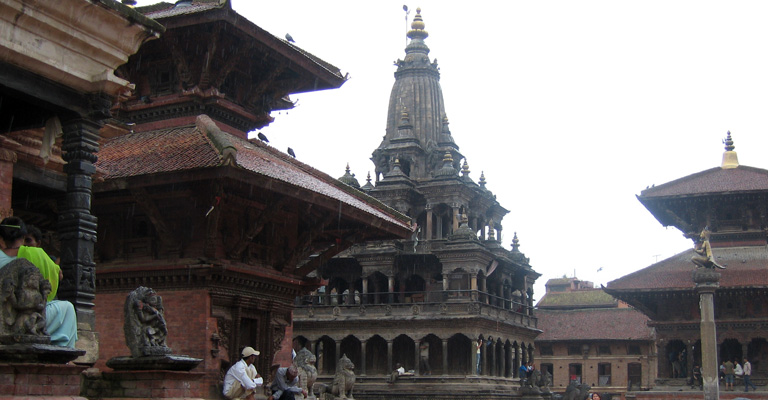
Patan
This whole square (World Heritage Site) is a cluster of fine pagoda temples and stone statues; it is at the same time the business hub of the city. At every step one comes across a piece of art or an image of a deity, testifying to the consummate skill of Patan's anonymous artists. The ancient palace of the Malla kings and the stone baths associated with various legends and episodes of history are especially interesting to visitors. The stone temple of Lord Krishna and the Royal Bath (Tushahity) with its intricate stone and bronze carvings are two other masterpieces in the same vicinity.
Hiranya Varna Mahabihar
This three-storey golden pagoda of Lokeshwar in Patan was built in the twelfth century A. D. by King Bhaskar Varma. Located in the courtyard of Kwabahal, this temple is in a class of its own. A golden image of Lord Buddha and a big prayer wheel can be seen on the pedestal of the upper part of the Car while intricate decorative patterns on its outer walls add charm to the mellow richness of the shrine.
Kumbheshwar
This is a five-storey pagoda-style temple of Lord Shiva. Inside the courtyard is a natural spring whose source, it is said. is the famous glacial lake of Gosainkunda. This temple was built by King Jayasthiti Malla while the golden finial was added later, in 1422 A.D. He also cleaned the pond near Kumbheshwar and installed various images of Narayan, Ganesh, Sitala, Basuki, Gauri, Kirtimukh and Agamadevata around the pond and in the courtyard. Ritual bathing takes place here every year on the day of Janai Poornima.
Jagat Narayan
The Jagat Narayan temple is a tall shikhara-style temple consecrated to Lord Vishnu. The temple is built of red bricks on the bank of the Bagmati at Sankhamul and enshrines many stone images. The fine metal statue of Garuda placed on a stone monolith is quite eye-catching and is accompanied by similarly placed images of Ganesh and Hanuman.
Krishna Temple
The temple of Lord Krishna holds a commanding position in Patan's Palace complex. Though its style is not wholly native, it is one of the most perfect specimens of Nepalese templecraft. The three-storey stone temple continues to elicit high praise from lovers of art and beauty. It was built by King Siddhi Narasingha Malla in the sixteenth century A. D. Important scenes from the Mahabharata and Ramayana epics have been carved in bas-relief. The minute details of this work clearly show the high level that the art of stone carving attained in the sixteenth century.
Mahaboudha
The temple of Mahabouddha is a masterpiece of terra-cotta. Like the Krishna Mandir, it reveals an artistic tradition which evolved outside of Nepal and shows how native Nepalese craftsmen have been able to do justice to an unfamiliar art form. This temple was built by Abhaya Raj, a priest of Patan and is sometimes referred to as the temple of a million Buddhas because every single brick bears a small image of Buddha. There is an astonishing total of nine thousand bricks. It was levelled to the ground in the great earthquake of 1933 but was rebuilt exactly to the original specifications, proving that the templecraft is still one of the living arts of Nepal.
Ashokan Stupas
Popularly believed, though not proven without doubt to have been built by Ashoka, the Buddhist Emperor of India, these stupas stand at four different corners of Patan, giving the whole city a monastic character. All these Buddhist mounds were built in 250 A.D.at the time when Buddhism was making headway in the Kathmandu Valley.
Machhendranath Temple
The temple of Red Machchhendranath is another center of attraction in Patan. The temple lies in the middle of a wide, spacious quadrangle just at the outer rim of the market place. A fine clay image of Red Machchhendranath Avalokiteshwar is housed here for six months every year, after which it is taken round the city of Patan in a colourful chariot during the festival beginning in April-May and lasting sometimes for several months.
The Tibetan Camp
An attraction of a different kind is the Tibetan Camp on the outskirts of Patan. The small Tibetan population living here has set up a number of shrines and stupas as well as several souvenir shops offering authentic Tibetan handicrafts such as prayer wheels of wood, ivory, silver or bronze, long temple horns made of beaten copper, belt buckles, wooden bowls and jewellery. In this area, the Tibetans can be seen weaving carpets by hand.
